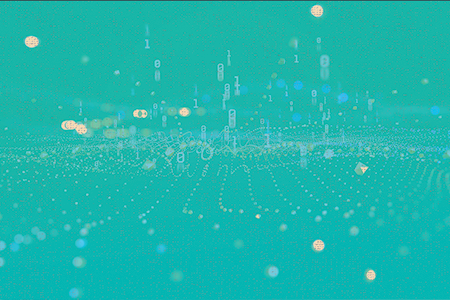- 09/07/2023
Ordinals Mini Proof-of-Concept
In April of 2023, Fidelity Center for Applied Technology’s (FCAT) Mining Team created its first experimental Bitcoin inscription with the assistance of an AI image generator. This ordinal, a Bitcoin-themed collage featuring the team’s furry friends, was assigned a unique number that marked its permanence on the Bitcoin blockchain. The image to the right is the original image used to generate the inscription.
The creation of this ordinal required a transaction fee of 29,000 satoshis (equivalent to $9 at the time of writing) and occupied 38 KB of space, approximately 1% of the maximum 4 MB size of a single Bitcoin block. This ordinal, along with thousands of other transactions in the same block, added to the 550 GB size of the entire blockchain.
Now that we’ve explained an example of an ordinal, let's delve into some key terminology.
Essential Jargon
Ordinal Theory and Ordinals
Ordinals were introduced to the Bitcoin community by Casey Rodarmor in December 2022. At its core, ordinals are a tracking mechanism for the Bitcoin blockchain. Ordinal Theory refers to a numbering system used to track individual satoshis (the smallest unit of Bitcoin, where 1 BTC equals 100,000,000 satoshis). Ordinals are assigned numbers linked to specific satoshis, and satoshis are numbered based on a first-in-first-out order, reflecting the order in which they were mined and transferred. The maximum number of ordinals possible is 2,100,000,000,000,000, corresponding to the fixed 21,000,000 supply of bitcoins.
A helpful mental model for understanding ordinals is to make a comparison to sports jerseys. Referees during a game—let’s say a soccer match—need a way of tracking players, whether a player scores or if a player receives a penalty. Players are given a unique number between 0 and 99, similar to how ordinals assign unique numbers to satoshis. Some numbers may even hold extra meaning—for example, the #1 jersey in soccer is typically reserved for goalies. In ordinal theory, certain ordinals may have greater rarity, for example an “epic satoshi", which are satoshis that follow halving events. Additionally, creating an ordinal requires running a full bitcoin node (on your own or through a third-party) with specific configurations, much like producing jerseys would require specialized manufacturing resources.
Inscriptions
Inscriptions are data elements that can be added to a satoshi to create an ordinal. They commonly come in the form of text (e.g. “.txt”, “.json”) or images (e.g. “.png”,”.jpeg”). For instance, one could attach their name "Alice" as text data to a specific satoshi, or as shown in the FCAT Mining Team’s ordinal, one could inscribe an image. Back to our analogy, if ordinals are the numbers on the back of jerseys, inscriptions would be the content—name of the player, images of sponsor logos—that is added to individual jerseys.
| Ordinals | Inscriptions | |
|---|---|---|
| Use Case | Tracking individual satoshis | Storing data |
| Data type | Unique identifier | Various data types (text, image, etc.) |
| Analogy | Sports jersey number (e.g. #1) | Name, sponsors, and other content added to individual jerseys |
As a bit of historical context, the introduction of segregated witness ("SegWit") in 2017 and later Taproot in 2021 paved the way for inscriptions. SegWit allowed data to be incorporated into the “witness” section of a transaction that previously didn’t exist, and consequently, increased the maximum block size limit from 1 MB to 4 MB. Taproot introduced a new scripting language (scripting languages dictate how transactions are processed) called TapScript that ultimately lowered storage limitations for transactions. Together, both upgrades made it possible to create inscriptions of various data types.
So, are inscriptions just NFTs on Bitcoin?
Not exactly. There are notable differences. Although inscriptions can be text, images, or other data, NFTs, on the other hand, are primarily associated with images on other blockchains such as Ethereum. Bitcoin inscriptions are directly stored on the blockchain, specifically in the witness data of a transaction, providing them with the security of the Bitcoin network. In contrast, NFTs are typically stored off-chain using systems like InterPlanetary File System (IPFS), making them less secure. Additionally, NFTs often utilize smart contracts and require individual audits, whereas inscriptions do not rely on smart contracts. It's worth noting that NFTs on Ethereum offer a higher maximum size of 100 MB, whereas inscriptions are limited to 4 MB.
Key Trends
At the time of writing, over 20 million ordinals have been created since they hit crypto mainstream in February 2023. Here are some noteworthy trends that have emerged so far:
- The majority of ordinals are text-based, comprising over 90% of inscriptions, while the remaining are images. Most text-based ordinals are tokens, which we’ll discuss later in the “Token Standards” section.
- Ordinals have contributed to the increased size of the Bitcoin blockchain. Since their introduction, the average block size has increased by 75%, from around 1.2 MB on average per block in June 2022 to approximately 2.1MB in March 2023 (Figure 3). As average block sizes have increased chain data storage requirements, nodes will need to account for higher-than-expected storage limits.
- The demand for block space has risen, leading to periods of higher fees and may increase security to the network as miners have greater incentive to participate in consensus. More than $50 million has been spent on transaction fees for ordinals, resulting in an average of ~$250,000 per day in fees collected by miners.1
- In terms of block rewards, miners saw a substantial spike in average monthly block rewards between April and May 2023 from approximately 6.3 BTC to about 7.3, which serves as another indicator of increased revenue for miners, and by extension, potentially greater security to the network (Figure 3).
- Despite the rise in fees on the base layer, the adoption of Lightning Network has not seen significant growth as some may have expected. In fact, the number of channels has decreased from approximately 80,000 at the beginning of the year to around 70,000 in June 2023.2
Token Standards
In April 2023, there was a notable surge in the creation of "BRC-20" tokens, which offered an additional application of inscriptions. These tokens allow users to inscribe JSON data snippets to generate and transfer new tokens. However, it’s important to note here that these tokens (unlike “ERC-20s” on Ethereum) have certain limitations such as lacking smart contract capabilities. They are fungible, meaning that each token can be exchanged on a one-to-one basis with another token, and therefore differ to most image inscriptions that are non-fungible. The figure to the right showcases an example BRC-20 inscription that depicts a user transferring 500 units of a token named “ordi”; transfers are one of the three core functions (mint, deploy, and transfer) of a BRC-20 token and simply allow users to send and receive tokens.
We have also started to see the emergence of other protocols, in addition to BRC-20s, that can be thought of as new “token standards.” Each standard has its own unique parameters and nuances, and while they are currently in an experimental stage, it will be intriguing to observe their evolution and potential advancements.
Ecosystem Considerations
Markets
At the moment, markets for ordinals are limited. Buying and selling ordinals can be inefficient or difficult, for the average user. This is due to a lack of liquidity and tooling (not many wallets support ordinals). Moreover, users must self-manage separate Bitcoin wallets for ordinals and bitcoin transactions, otherwise they risk losing their ordinals from mixing wallet types. At the time of writing, daily volume across marketplaces averages less than $1 million, which may be an indication of how nascent the space is—as a point of comparison, individual centralized exchanges often transact well over 10 times the amount. As more use cases begin to surface, and infrastructure improves, markets for ordinals can likely grow.
New Use Cases
We’re already starting to see new and potential use cases for ordinals on Bitcoin. Some of the use cases listed in the below table benefit from a new development in the space called recursive inscriptions—recursive inscriptions are formed by extracting data from numerous pre-existing inscriptions. This allows users to bypass the 4 MB per block limit and create larger data files such as gaming applications and websites.
| Use Case | Description |
|---|---|
| Naming Systems | Naming systems, similar to domain names, allow users to register names such as “rosie.sats” or “charlie.btc” |
| NFT Collections | Content creators can create digital collectibles for users in the form of unique artwork |
| Inscriptions as a Service | Node operators can charge a fee for providing inscription services. For example, Gamma has offered inscription minting services since Q1 2023.3 |
| Mining pool service for full-block inscriptions | Mining pools have added a new revenue source via ordinals, charging a back-door fee for assistance mining full blocks with an ordinal |
| News / Advertisements | Individuals or businesses can inscribe messages on the blockchain for advertising purposes and/or recording important news events |
| Recording Ownership | Users can inscribe data files of their choice for a higher degree of permanence |
| Websites | Users can create more complex types of inscriptions such as websites through recursive inscriptions |
| Ticketing | Ordinals may be used in the future to signify ownership |
| Gaming | Through recursive inscriptions, interactive games can be created from one larger ordinal that references smaller individual ordinals |
Risks
While ordinals are an exciting new development in the space, it’s important to highlight some risk areas:
- New experimental tokens are subject to price volatility and currently offer limited functionality.
- Marketplaces may offer collections that can’t be fully trusted, have limited liquidity, and are susceptible to market manipulation.
- Users should be aware of wallet risks such as losing funds through mixing addresses across transactional wallets and ordinal wallets.
- Users can inscribe any (uncensored) data they wish, some of which may be inappropriate or unlawful.
- Inscriptions are irreversible—once you put one out there, you can’t take it back.
- The emergence of ordinals may result in further resistance around future Bitcoin Improvement Protocols (BIPs)—inscriptions were an unintended consequence of SegWit and Taproot.
- There may be regulatory risks from transacting certain inscription types that are currently undefined (e.g. if a specific BRC-20 token was deemed a security).
Conclusion
To summarize, ordinals are creating a buzz in the Bitcoin community, bringing a fresh wave of interest to the space. Previously, Bitcoin was predominantly known for its financial transactions and as a potential store of value. However, with the introduction of ordinals, we could see a surge of creativity and innovation on the Bitcoin network. Not only does this offer new possibilities, but it also may enhance the security of the network through increased fees for miners and therefore the security budget of the network. If ordinals grow in demand, we may also see more full nodes come online, which could further decentralize the network. This convergence of creativity, security, and network growth marks an exciting chapter in the evolution of Bitcoin.
2 @BitcoinVisuals. (n.d.). Lightning Network Statistics. Bitcoin Visuals.
3 Gamma.io. (n.d.). Gamma.io Announces No-Code Creator Platform for Native Bitcoin Ordinals NFTs. www.prnewswire.com.










